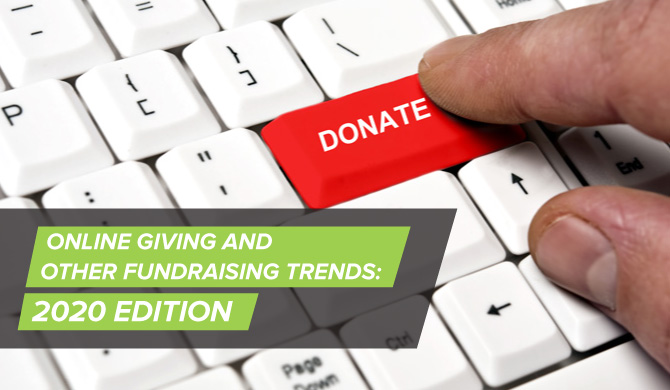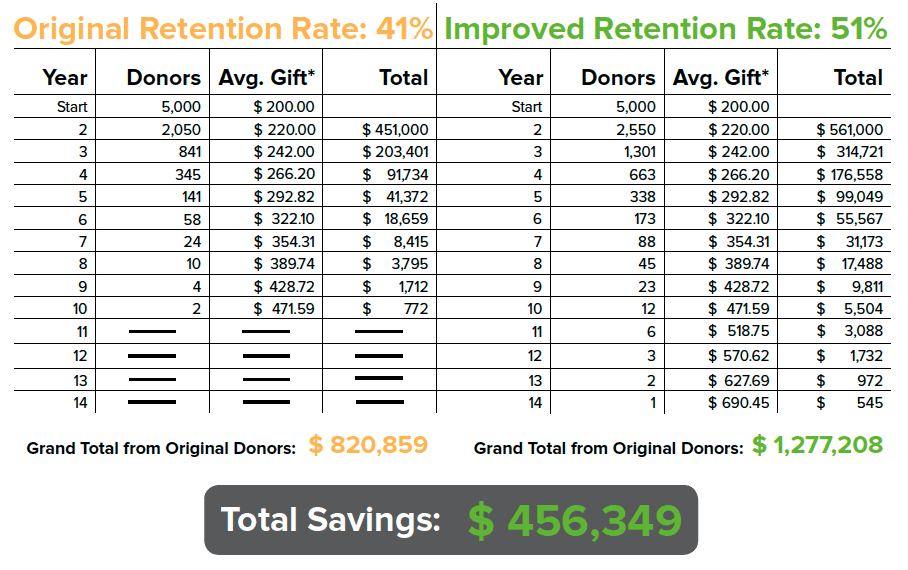-
Software
Compliance Software
Oversee licenses, track renewals, access documents, and more from a single interface.
Software Overview -
Services
Compliance Services
Full service compliance solutions for organizations throughout their entire lifecycles.
Services Overview -
Industries
-
Partner
- Information Center
Online Giving and Other Fundraising Trends: 2020 Edition
Posted on March 11, 2020 by Harbor Compliance in Fundraising and Grants.

Nonprofits have a reputation of being behind the times in terms of the trends that emerge from year to year. However, if your nonprofit is able to keep up with these trends and incorporate them into your daily strategies, you’ll find yourself one step ahead of your fellow organizations and better able to advance your cause.
Therefore, as we dive deeper into 2020, keep an eye on the emerging trends and adhere to them when crafting your annual strategies.
In this guide, we’ll touch on some of the most impactful fundraising trends for 2020 that your nonprofit should take into account in order to see success for the remainder of the year. These fundraising trends include:
- Donor Retention
- Relevant Events
- Big Data
- Corporate Social Responsibility
- Political Biases
- Storytelling
Nonprofits, especially young nonprofits1, that incorporate the latest trends in their strategies see great success in their growth goals. Keeping up with the times pays off!

1. Donor Retention
Since 2013, nonprofits have seen a steady incline in the number of individual contributions provided. However, in 2018, the first drop since that year occurred as individual giving fell 3.4% (when adjusted for inflation).2
There are various theories as to why this drop occurred, but none have been verified as certain. However, one valid potential reason is the change in the tax code to raise the standard deduction rate, which provides lesser incentive to give. No matter what the reason, drops such as these make it more difficult for nonprofits to secure new individual donations.
That’s just one reason it’s so important to retain the donors you’ve already secured. Not to mention, it’s less expensive to retain donors than to secure new ones. Plus, you can cultivate larger donations from existing donors.
Really, there are a whole slew of reasons to retain more donors. Bloomerang shows how an improved retention rate of 10% can save a sample nonprofit $456,249 with an average gift of $200 and 5,000 donors3. See below:

In order to help your nonprofit boost your own retention strategy in 2020, consider the following strategies:
- Personalize outreach. Instead of sending general emails and communications, make sure you personalize each message you send. Send different messages to the most relevant donor segments and use the individual donor’s name to show personal attention.
- Vary giving opportunities. It can become tedious for your donors to receive the same “donate now” emails over and over again. Instead, send opportunities for events to attend, volunteer openings, advocacy campaigns, and more in addition to the donation solicitations.
- Say thank you. Gratitude goes a long way for donors. As you establish your relationships with them, you’ll need to show them you care about their involvement. Handwritten notes, phone calls, and other immediate donation acknowledgments help foster the growing relationships you have with supporters.
Donor retention isn’t a new concept, but given recent trends, it’s becoming more and more important for nonprofits like yours. Building and stewarding relationships is the first step to retaining more supporters.

2. Relevant Events
Events have always been a major part of a nonprofit strategic plan. They’re probably the backbone of your calendar and provide major opportunities for donor engagement with your organization.
This year, many nonprofits will do the same thing for their events: A 1920s theme.
We recommend that nonprofits don’t adopt this theme4. Yes, it’s 2020 and technically we are, yet again, in the 20s. However, events with this theme are rarely associated with your nonprofit’s brand. It’s much better for your organization’s marketing strategy to choose a theme that’s better related to your mission or to a specific project.
You already know your supporters are interested in your mission, however, you don’t know if they were Great Gatsby fans. Plan your events taking into consideration the already-known interests of your supporters.
However, while you plan your non-1920s party, we’ll give you a couple of ideas on how to better engage those donors. These ideas include:
- Gamification.5 Incorporate fundraising thermometers, top donor scoreboards, or badges for donations made at or leading up to the event. These gamification strategies encourage friendly competition among donors and drive fundraising further.
- Donor-centric experiences. Your donors are caring, empathetic people. Make sure you touch that side of them and create an event experience they won’t forget. For example, an animal shelter might invite supporters to bring their furry friends to a cookout in order to make the experience more personal while also acknowledging their ties to your mission.
- Follow up. After the event is over, be sure to follow up with donors almost immediately. Remind them of how much fun they had at the event, send pictures, and thank them for attending. This simple act helps drastically to build relationships with your donors.
Appropriate-themed events are key to engaging your supporters to the best of your ability. Don’t host the typical and cliche Gatsby-themed gala. Make it personal and fun for your donors and their interests.

3. Effective Data Usage
Data is everywhere. Consider how many times you pull your phone out to do a Google search for the smallest tasks. In fact, Google handles over 75,000 queries per second6. While nonprofit professionals may not need to Google every aspect of their personal and professional lives, they do notice the impact that data has on our day-to-day lives.
Just as big business does, nonprofits can also harness data about their constituents and donors to better understand them and build relationships.
Prospect research allows nonprofits to better understand their donor’s wealth status to better craft fundraising asks. Plus, recording and storing engagement data can help your organization better personalize appeals.
Use your fundraising software7 and CRM solution to collect and save relevant data for each supporter. For instance, save information such as:
- Events attended
- Past donation amounts
- Past method(s) of giving
- Matching gift eligibility
- Relationships with other donors
When you save relevant information in an organized manner, you can quickly find and easily use information about your donors to build relationships.
Eliminate your donor management blues8 and save relevant data as we dive deeper into 2020.

4. Corporate Social Responsibility
More and more, corporations are realizing the importance of corporate social responsibility (CSR). People respond positively when they know they’re supporting a company that gives back to the community. Therefore, CSR is on the rise in 2020.
CSR describes the actions of a company aimed to improve the community in one way or another.9 The company may decide to give money directly to a nonprofit, provide matching gift opportunities to their employees, or schedule company volunteer days for their employees.
Nonprofits also can benefit from these CSR programs if they know where to look. Some potential steps for your nonprofit to take to receive CSR benefits include:
- Invest in a matching gift database. Matching gift databases can be embedded on your donation forms. This resource allows donors to search their employer’s name to see if they have a matching gift or volunteer grant program to take advantage of.
- Partner with a company. Find a business that closely aligns with the mission of your nonprofit. Partner with them and encourage them to set up company volunteer days, sponsorships, in-kind gifts, and more in exchange for additional marketing (publicly recognize the company as a partner).
CSR is a valuable resource for nonprofits, but not taken advantage of often enough. Make sure your nonprofit is putting in the effort to find and facilitate the use of CSR programs so that they reap the benefits fully.

5. Political Biases
Whether your nonprofit is politically motivated or not, the election will likely have a political impact on the majority of nonprofits.
For politically-minded nonprofits…
This is your time to shine! Election years provide a platform to bring your issues to the table, to better target your ideal audiences, and to raise more money for your cause.10
During 2020, collect data about your supporters (and potential supporters), such as their past political contributions11 and party registrations to better understand their political leanings and preferences. Then, reach out to them and explain how your nonprofit can make a difference during such a critical time in the country’s history.
For non-politically-minded nonprofits…
Election years heighten everyone’s senses to the key social issues of the day. If you’re not involved in politics and don’t want to receive the backlash of supporting one party over another, you should stay as neutral as possible in all media releases and outreach communications.
However, if you or your audience naturally lean toward one party or the other, you may decide to nod toward important issues that are brought up in the debates and media so long as they are related to your mission.

6. Tell Stories
Telling stories is a tried and true way to engage your supporters and prospects. This is not changing in 2020! For centuries, humans have passed down stories from generation to generation. We love listening to them and always have.
Sometimes, the best “new trends” are actually the old ones reimagined. In 2020, the fact that we love stories hasn’t changed. However, our methods of delivery have changed slightly. Instead of telling stories around the campfire, we can now reach broad audiences on social media, websites, in direct mail, and over email. It’s clear that storytelling is now a crucial part of successful nonprofit marketing strategies.12
As you’re crafting your outreach strategy, consider the donor segments you’re reaching out to. What information do you have in your CRM13 about their interests and motivations? With this in mind, craft your story. Be sure that your story is:
- Focused. Focus on a single subject. Write about that one family your organization helped out of a hard situation, the cat who you found a new home for, or the little boy you helped send to college. Provide a name for this subject and pull at the heartstrings of your donors.
- Descriptive. Part of telling a story is painting a picture in the heads of your donors. Paint this picture with descriptive words and vivid imagery. It can help to even include an actual picture!
- Future-oriented. Make sure there’s a call to action after you’re done telling the story. Give your supporters something concrete they can do to make a real impact. You’ve sparked their interest, so keep it going with a clear next step such as donating, volunteering, or attending your next event.
Storytelling grabs the reader’s attention. It makes your supporter feel closer to your mission and more connected to your nonprofit. Once you’ve got your supporters invested, then, you can ask them to engage further by getting involved.
Fundraising trends can help your nonprofit get ahead in 2020. Incorporate these strategies into your plan for the year. Keep up to date this year and in the future to make sure your nonprofit continues to grow and engage supporters.
For more information about these trends, check out the resources below.
Resources:
- https://www.harborcompliance.com/blog/fundraising-for-new-nonprofits-4-strategies-to-get-started/
- https://www.forbes.com/sites/nextavenue/2019/06/18/charitable-giving-took-a-hit-due-to-tax-reform/
- https://bloomerang.co/retention
- https://bloomerang.co/blog/3-reasons-why-nonprofits-shouldnt-have-1920s-gatsby-themed-fundraising-galas/
- https://www.harborcompliance.com/blog/fundraising-gamification-the-right-and-wrong-time-to-do-it/
- https://99firms.com/blog/google-search-statistics/#gref
- https://bloomerang.co/blog/buying-fundraising-software
- https://www.harborcompliance.com/blog/8-strategies-to-eliminate-your-donor-management-blues/
- https://doublethedonation.com/tips/corporate-social-responsibility/
- https://www.bonfire.com/fundraising/political/
- https://www.harborcompliance.com/blog/prospect-research-3-things-you-should-know-about-your-donors-before-making-a-solicitation/
- https://www.harborcompliance.com/blog/successful-nonprofit-marketing/
- https://bloomerang.co/blog/nonprofit-crm/

Author: Steven Shattuck
Chief Engagement Officer at Bloomerang
Steven Shattuck is Chief Engagement Officer at Bloomerang and Executive Director of Launch Cause. A prolific writer and speaker, Steven is a contributor to “Fundraising Principles and Practice: Second Edition” and volunteers his time on the Project Work Group of the Fundraising Effectiveness Project and is an AFP Center for Fundraising Innovation (CFI) committee member.





